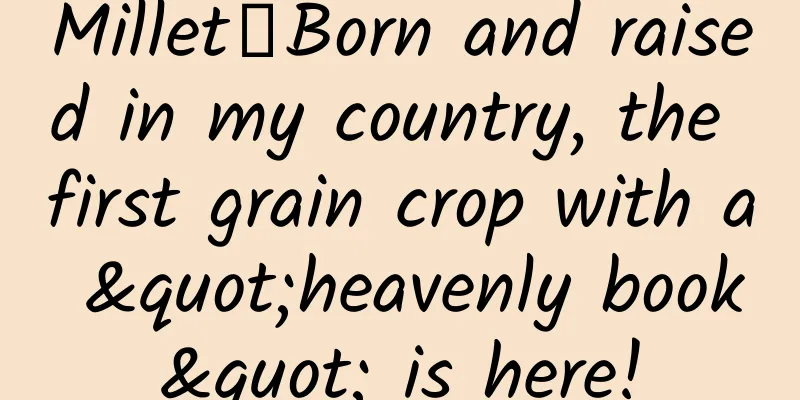Millet丨Born and raised in my country, the first grain crop with a "heavenly book" is here!

|
Our country has a vast territory, rich resources, and countless native crops. Today, Xiaonong will talk to you about the best of them. In the mind of the poet Du Fu, it is one of the symbols of a peaceful and prosperous age. The granaries are filled with it, and it is also the scene that our ancestors pursued throughout their lives. Yes, you guessed it right, what Xiaonong wants to talk to you about today is millet. Millet, formerly known as millet, millet, and also called sorghum, is an annual herb belonging to the genus Setaria of the Poaceae family. When the ears of millet are mature, they are mostly golden yellow, with oval seeds and small grains. After peeling, they are commonly known as millet . When it comes to the importance of millet, it is probably unmatched by any other grain. Xiao Nong looked through ancient books and found many records about millet: There is an allusion to Hou Ji sowing hundreds of grains: In the Book of Songs, Da Ya, Sheng Min, it is written: "When Qi was a child, he liked to plant trees, hemp and beans. When he grew up, he was good at selecting the right land, planting grains and crops, and teaching the people how to farm. When Yao heard about it, he appointed him as a teacher of agriculture, and the world benefited from his work. He made great contributions. He granted Qi a fief in Tai, named Hou Ji, and gave him a different surname, Ji." Hou Ji (the ancestor of Zhou Dynasty) was of Ji surname and named Qi. Qi was good at planting various crops. After he became an adult, he was good at identifying which piece of land could produce the highest grain yield, and he began to teach the people how to farm. When Yao and Shun heard about it, they made him an agricultural official to teach the people how to farm. He was the first to establish a grain reserve and the 畎亩法, to release grain to relieve hunger, and to give seeds to the people. He was considered one of the three officials that Yu relied on the most. Therefore, Hou Ji was revered as the Ji King (also known as Ji God), the God of Agriculture, the God of Farming, and the God of Grain. He was the ancestor of farming and the god of grains. There is an idiom story about not eating Zhou millet: According to the biography of Boyi in Records of the Grand Historian by Sima Qian of the Western Han Dynasty, "King Wu had pacified the rebellion of Yin, and the whole world was under the rule of Zhou. However, Boyi and Shuqi were ashamed of this and refused to eat Zhou millet. They hid in Shouyang Mountain and ate wild vegetables." When King Wu of Zhou succeeded to the throne and led his army to attack King Zhou, they thought it was unkind for the princes to attack their king and tried their best to dissuade him. King Wu refused to listen and was determined to destroy Shang. Boyi and Shuqi sneered at King Wu's behavior and vowed to never be subjects of Zhou, nor eat Zhou's millet and other food. They lived in seclusion in Shouyang Mountain and made a living by picking wild fruits. There are records of millet being used as currency: In addition to its most basic food function, millet has many special uses. Millet was once used as official salary. "Guangya·Shigui" says: "Millet means salary." Millet was used as a reward. Gu Yanwu explained in "Rizhilu": "In ancient times, money was not widely used. There was no mention of money in poetry and books, but fortune-tellers also used millet, and this was still the case in the early Han Dynasty." Liang Qichao believed that millet was once a currency. In his article "Research on Ancient Chinese Coins and Coins", he said: "In ancient times, millet was used as currency. All the millet in the country was used to feed the people and to provide currency. When millet was scarce in bad years, both were indispensable." Millet was also used to promote officials, grant titles, and reduce sentences. When the Han Dynasty was at war with the Xiongnu, many soldiers were stationed at the border, but grain was insufficient. So the Han Dynasty recruited people who could transport millet to the border and grant them titles, with the highest title being the Great Shuzhang. There are records of being used as cultural symbols: There are many poems about millet in the Book of Songs, such as "Yellow bird, yellow bird, do not gather in the grain, do not peck my millet". Su Dongpo sighed in "Preface to the Red Cliff": "I am a mayfly in the world, a grain of sand in the vast ocean." Hence the well-known idiom "a grain of sand in the vast ocean" came into being. Millet has also been used to compose words, such as millet-like small grains of gold are called "millet gold", millet-like patterns are called "millet text", slight mistakes are called "millet errors", extremely small quantities are called "millet xu", small countries are called "millet scattered", and goose bumps caused by cold skin are called "millet skin". Xiao Nong has said so much, maybe you might want to ask, Millet is good, but Is millet really a crop native to my country? No, it’s also an “imported product”, right? This time, small farmers can confidently say, The origin of millet is in our country! According to Diao Xianmin, the leader of the team for the exploration and innovative use of excellent germplasm resources of characteristic crops at the Institute of Crop Sciences of the Chinese Academy of Agricultural Sciences and the chief scientist of the National Millet and Sorghum Industry Technology System, China has a very long history of domesticating and cultivating millet. Archaeologists have discovered carbonized millet that is more than 11,000 years old at the Donghulin Man Site in Mentougou, Beijing. From about 6,000 to 5,000 years ago, the cultivation of millet became increasingly prosperous. A large number of millet traces were found in the sites of the Yangshao Culture and the Hongshan Culture. Many historians believe that during this period, the population of the Central Plains experienced its first explosive growth, and millet cultivation was one of the important foundations. Scientists have had many speculations about the origin of millet. Some believe that millet originated in China, while some scientists believe that millet originated in Europe or Central Asia. However, with the advancement of science and technology, more and more discoveries have proved that China is the only origin of millet. Recently, a study from the Chinese Academy of Agricultural Sciences was published in the journal Nature Genetics. The Institute of Crop Science has cracked the "holy book" of millet genome with high-quality images, proving that all millets in the world come from China . Based on high-coverage deep sequencing, this study clarified the population structure, classification and evolutionary relationships of wild millet species, farm varieties and modern bred varieties, and explained the origin of millet and the process of domestication and improvement; these population genetic evidences clearly show that millet has a single origin, that is, all millet in the world comes from China. my country is not only the country of origin of millet, but also preserves the largest number of millet resources in the world. Liu Xu, an academician of the Chinese Academy of Engineering, pointed out that this study clarified the genome variation background of three types of millet resources: wild species, farm varieties, and modern bred varieties, and understood the subgroup classification and geographical distribution of the three types of resources and the possible process of their evolution. It genetically confirmed the theory of a single origin center for millet, namely the Chinese origin center, and is a typical example of using new technologies for resource research. So, here comes the question again, Millet originated from my country. And it is widely popular among the people. Why? Why has millet gradually withdrawn from the ranks of “staple food”? Millet: Once the staple food Millet has long been the staple food in farming culture. But with the rise of the green revolution in crops such as wheat and rice, The advantage of millet as a staple food has been gradually weakened. As early as 1942, the older generation of Chinese scientists determined that Green Setaria was the wild ancestor of millet. However, compared with other major crops, millet production is still very low, mainly because people do not have a clear understanding of the population structure and evolutionary history of millet breeding varieties. Researcher Diao Xianmin explained that the most fundamental problem is to decipher the "holy book" of the millet genome. Over the past thirty years, the research team has collected 1,004 cultivated and wild millet samples, combined with 840 published materials, totaling 1,844 germplasm resources, and used deep resequencing to conduct a detailed population genetic analysis of millet evolution. Analysis of Genetic Characteristics of Millet Population Finally, the hard work paid off, and the research team discovered 1,084 important trait-related sites and genes in 1,844 core germplasm resources, and successfully mapped the first high-quality genome of millet. This is also the first high-quality pan-genome in the field of coarse grains. This work is not only another "milestone" in millet research, but also the best interpretation of "small crops - big achievements", and will play an important role in promoting research on other crops. Qian Qian, an academician of the Chinese Academy of Sciences, pointed out that this research allows people to see more clearly the importance of genome structural variation in discovering gene functions, provides a genomic and phenotypic data foundation for the millet model plant system, comprehensively improves the breeding level and yield quality potential of millet, and enables my country to maintain an international leading position in millet basic and breeding research. The branches and leaves are luxuriant, The grains are plentiful. Millet is transformed from foxtail grass. Represents the wisdom of agricultural civilization. It also symbolizes the excellent qualities of hard work and perseverance of the Chinese people, and is a precious gift that the Chinese nation has contributed to all mankind. Millet culture is deeply imprinted in the spiritual world of the Chinese people and has a profound impact on people's thinking and humanistic feelings. Do you like native millet? |
<<: Popular Science Illustrated | Sneak peek! See how technology empowers the Chengdu Universiade
>>: Chinese scientists have made new research results! 2 million people may be reborn!
Recommend
AMD Ryzen's biggest performance shortcoming is confirmed: it is still difficult to compete with Intel
After the AMD Ryzen series processors were launche...
WeChat this year: 16 emoticons were quietly removed from the platform, and these functions will be gone forever...
In 2020, WeChat launched system emoticons once at...
Hybrid development: AppFrameworks mobile development framework defines page layout
In this code, we will use the appframeworks frame...
The Yellow River is not "yellow" anymore! Can it still be called the "Yellow River" after it becomes clear?
Is the Yellow River going to be renamed? This riv...
Google, BlackBerry team up to make Android devices more secure
BlackBerry has announced a partnership with Googl...
How to start a new takeaway store "Seven Steps to Build 9999+" Practical Operation of a New Takeaway Store with Ten Thousand Orders
Training course content: Let’s start with the thr...
Talking about Android security 2 - Activity hijacking prevention program
The previous article introduced phishing vulnerab...
Can the 1799 yuan price tell the truth? Meizu MX4 full review
In September this year, the mobile phone industry...
Classic "Event Marketing" Cases You Must Know When Operating an App
Topic marketing and event marketing are unfathoma...
New Brand Marketing Model-Reflective Marketing Thinking
In marketing work, we often encounter the followi...
Luo Xinyu: What is it like to go on a field scientific expedition?
"In the field, 10 percent of it is about how...
B-end product operation skills and strategies!
If B-side products are compared to people, a good...
Parse Tutorial: Network Backend Basics
[[141390]] This tutorial has been updated for Swi...
Challenging MOTO 360? Geak Watch II is more than just a round watch face
In today's smart technology industry, various...
Can eating more duck eggs lower blood pressure? The truth is...
Rumor: "People with high blood pressure shou...









